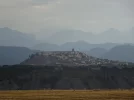To see many of these routes on a map, go to the
Mundicamino website. You can link to information about suggested daily stages.
An excellent tool for planning a day-to-day itinerary for some routes is the Camino Planner at
https://godesalco.com/plan. Another tool that provides route information and accommodation options is
gronze.com.
It is useful to think of the Camino as a
network of walking paths leading to Santiago de Compostela, based on the routes that pilgrims have used over more than 1000 years as a pilgrimage to the tomb of Santiago (St. James). In olden times, people would start at their home or parish church wherever it was (in Europe), walk to Santiago and home again.
A common misunderstanding is that there is a single governing body that manages the Camino. There isn't. There are many local governments along the routes, and local associations that maintain paths and promote the Camino in their region, but each operates according to their own laws and objectives. Many of those associations are members of the
Federación Española de Asociaciones de Amigos del Camino de Santiago, but there are other organizations and websites to help pilgrims.
Is the Compostela important?
People can start at any point they choose. However, if they want to receive a Compostela from the Cathedral in Santiago, they must have walked the last 100 km or cycled 200 km of one of the approved routes. That's why many people who don't have much time will start walking at Sarria on the
Camino Frances, or at Tui on the Camino Portuguese, or they walk the Camino Ingles. Those are shortest routes that qualify for the Compostela. For official information about the Cathedral and compostela, and statistics about pilgrim arrivals, see the website of the Cathedral
Pilgrim Office.
Is it important to have many companions and reliable infrastructure?
By far the most popular route with the best developed infrastructure is the
Camino Frances. The route by this name starts in St. Jean Pied de Port in France, crosses the Pyrenees to Roncesvalles in Spain, and continues over 800 km across Spain to Santiago. It's important to understand that it is not the be-all and end-all of Caminos, the "official" route, the "whole Camino" or anything of the sort. See
this thread if you still need convincing about that.
Do you speak Spanish?
You can get away with speaking almost no Spanish on the
Camino Frances. In fact, if you WANT to practice your Spanish, you might be disappointed! On less popular routes, you will have more challenges to communicate, but here's where your personal comfort level matters.
Are you comfortable with day-to-day coping challenges?
These are generally not major issues, and most people do fine, but on less popular routes, you need to be a little more flexible and self reliant. On the
Camino Frances, everybody around you knows exactly what you are looking forward and there is usually someone nearby who speaks English. On less popular routes, people are still extremely helpful but it can be more of a challenge. Distances between lodgings may be longer and you need to be able to develop a plan B from time to time. You might be walking alone most of the time.
Have fun! Some people just like to show up, but others really enjoy detailed planning.


























